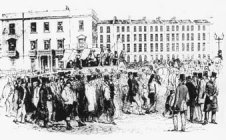The temporary defeat of trade unionism in 1834 had the effect of concentrating working class activity on three other mass campaigns:
'short time' committees - a mass movement demanding the regulation of working conditions and hours of work in the factories
mass opposition to the new Poor Law Amendment Act of 1834 (this act abolished 'outdoor relief' and condemned the poor to the hated workhouses)
Chartism
Chartism was a political movement based on
the demands of a
6-point Charter. Its mass
support was clearly visible in the presentation of three 'monster'
petitions to parliament in 1839, 1842 and 1848 containing millions
of signatures. At first Chartism won support from a wide variety of
workers and even from lower middle class radicals. From this mass
support came the formation of the first ever working class political
party - the National Charter Association, founded in 1840.
Chartist leaders like William Lovett and Feargus O'Connor represented the high point of a long radical tradition. However, others within the leadership were gravitating away from radicalism and towards socialism. Bronterre O'Brien ('the schoolmaster of Chartism') and later leaders like George Julian Harney (editor of the Chartist paper The Northern Star) and Ernest Jones made connections between political oppression and economic exploitation. (Harney and Jones were closely associated with Karl Marx and Friederich Engels who lived in Britain as political exiles from their native Germany).
Chartism posed an enormous threat to the established order. This was clearly shown by the 1842 General Strike (disparagingly referred to as the 'plug riots' when the plugs were removed from the cotton factory boilers, thus forcing them to stop work). The immediate cause of the strike was the proposal of the cotton manufacturers to cut wages by 25% because of the severe trade depression. However, the strike was also political in character, involving the demand for the Charter as its central aim. At countless meetings the strikers passed resolutions declaring that they would not return to work "until the People's Charter is the law of the land".
1848 was the year of revolution throughout Europe. In Britain, a huge Chartist demonstration massed in Kennington Common, London on 10 April 1848. The demonstrators had planned to march to Westminster to present the third Chartist petition containing almost two million signatures. The government responded with mass arrests of Chartist leaders, included amongst whom was William Cuffay - a black man, the son of a slave. Cuffay was a tailor and had emerged as one of the most prominent leaders of London Chartism. He was the main organiser of the Kennington Common meeting. He was later put on trial for 'levying war against the Queen' and sentenced to transportation for life to Van Diemen's Land (now Tasmania).
Chartism was not defeated in 1848, but it never again became the national mass movement that it once was. This is partly due to bitter internal divisions and partly due to a stabilisation of the economy which made the unity of working people less possible.
Professor Mary Davis, Centre for Trade Union Studies, London Metropolitan University
Back to top





